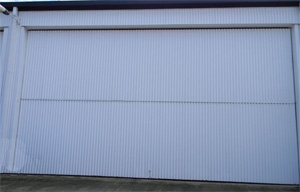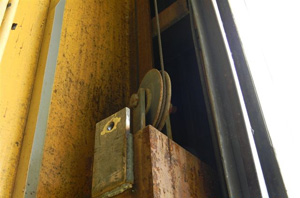Bi-fold horizontal workshop doors
Issued: 26 August 2013
Last Updated: 26 August 2013
Purpose
The purpose of this safety alert is to highlight the potential risks associated with the use of horizontal industrial bi-fold doors and the requirements for inspection, maintenance and testing.
Background
A worker died when a workshop horizontal bi-fold door measuring approximately four metres by four metres fell onto him as he opened it, due to the failure of the wire rope lifting mechanism.
Contributing factors
The type of bi-fold doors in this incident are opened manually by a person lifting the bottom of the door. A counterweight mechanism, located on each side of the door, assists the operator opening the door. The counterweights are connected by a wire rope which is attached to the bottom door panel via a set of pulley wheels which is housed behind metal guide plates.
The doors are heavier than the counterweights ensuring that the doors will move downwards under their own weight, regardless of the resisting effect of the counterweights.
In this case, the wire rope lifting mechanism failed as a result of general deterioration and corrosion in the rope over a period of time, reducing the strength of the wire rope.

Photograph 1: Typical horizontal bi-fold door

Photograph 2: The wire rope mechanism connected to a counterweight
Actions required
A person with management or control of a workplace must ensure that the maintenance, inspection and testing of these types of doors is carried out by a competent person and:
- in accordance with manufacturer's recommendations, if any; or
- if no manufacturer's recommendations, then in accordance with the recommendations of a competent person; or
- in relation to inspections, if not reasonably practicable to comply with a) or b) at least annually.
An inspection of doors should check that the opening and closing mechanisms are in a serviceable condition, including:
- wire ropes, chains, sprockets and pulleys that support the door
- guides, rollers, brackets and latches that make up the opening and closing mechanisms, including latches that hold doors open
- hinges or pivots in sectional or folding doors
- structural connections and supports between the building and the door.
Any covers should be removed to ensure all parts of the door mechanisms can be accessed for inspection and maintenance.
Legislative requirements
Work Health and Safety Regulation 2011 (s.213 - Maintenance and inspection of plant)
Further information
Further information may be obtained from the following: